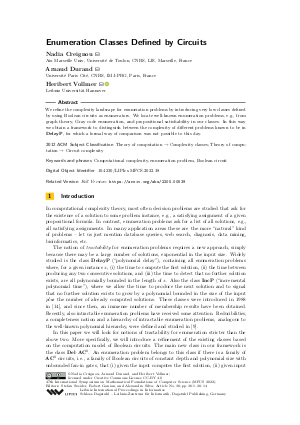Enumeration Classes Defined by Circuits
Authors
Nadia Creignou,
Arnaud Durand,
Heribert Vollmer 
-
Part of:
Volume:
47th International Symposium on Mathematical Foundations of Computer Science (MFCS 2022)
Part of: Series: Leibniz International Proceedings in Informatics (LIPIcs)
Part of: Conference: Mathematical Foundations of Computer Science (MFCS) - License:
 Creative Commons Attribution 4.0 International license
Creative Commons Attribution 4.0 International license
- Publication Date: 2022-08-22
File

PDF
LIPIcs.MFCS.2022.38.pdf
- Filesize: 0.78 MB
- 14 pages
Document Identifiers
Related Versions
- Full Version https://arxiv.org/abs/2205.00539
Subject Classification
ACM Subject Classification
- Theory of computation → Complexity classes
- Theory of computation → Circuit complexity
Keywords
- Computational complexity
- enumeration problem
- Boolean circuit
Metrics
- Access Statistics
-
Total Accesses (updated on a weekly basis)
0Document
0Metadata
Abstract
We refine the complexity landscape for enumeration problems by introducing very low classes defined by using Boolean circuits as enumerators. We locate well-known enumeration problems, e.g., from graph theory, Gray code enumeration, and propositional satisfiability in our classes. In this way we obtain a framework to distinguish between the complexity of different problems known to be in DelayP, for which a formal way of comparison was not possible to this day.
Cite As Get BibTex
Nadia Creignou, Arnaud Durand, and Heribert Vollmer. Enumeration Classes Defined by Circuits. In 47th International Symposium on Mathematical Foundations of Computer Science (MFCS 2022). Leibniz International Proceedings in Informatics (LIPIcs), Volume 241, pp. 38:1-38:14, Schloss Dagstuhl – Leibniz-Zentrum für Informatik (2022)
https://doi.org/10.4230/LIPIcs.MFCS.2022.38
BibTex
@InProceedings{creignou_et_al:LIPIcs.MFCS.2022.38,
author = {Creignou, Nadia and Durand, Arnaud and Vollmer, Heribert},
title = {{Enumeration Classes Defined by Circuits}},
booktitle = {47th International Symposium on Mathematical Foundations of Computer Science (MFCS 2022)},
pages = {38:1--38:14},
series = {Leibniz International Proceedings in Informatics (LIPIcs)},
ISBN = {978-3-95977-256-3},
ISSN = {1868-8969},
year = {2022},
volume = {241},
editor = {Szeider, Stefan and Ganian, Robert and Silva, Alexandra},
publisher = {Schloss Dagstuhl -- Leibniz-Zentrum f{\"u}r Informatik},
address = {Dagstuhl, Germany},
URL = {https://drops.dagstuhl.de/entities/document/10.4230/LIPIcs.MFCS.2022.38},
URN = {urn:nbn:de:0030-drops-168364},
doi = {10.4230/LIPIcs.MFCS.2022.38},
annote = {Keywords: Computational complexity, enumeration problem, Boolean circuit}
}
Author Details
References
-
Miklós Ajtai. First-order definability on finite structures. Annals of Pure and Applied Logic, 45:211-225, 1989.

- Bengt Aspvall, Michael F. Plass, and Robert Endre Tarjan. A linear-time algorithm for testing the truth of certain quantified boolean formulas. Inf. Process. Lett., 8(3):121-123, 1979. URL: https://doi.org/10.1016/0020-0190(79)90002-4.
-
Guillaume Bagan, Arnaud Durand, and Etienne Grandjean. On Acyclic Conjunctive Queries and Constant Delay Enumeration. In Computer Science Logic (CSL), pages 208-222, 2007.

-
David A. Mix Barrington, Neil Immerman, and Howard Straubing. On uniformity within NC¹. J. Comput. Syst. Sci. (JCSS), 41(3):274-306, 1990.

- Christoph Berkholz, Fabian Gerhardt, and Nicole Schweikardt. Constant delay enumeration for conjunctive queries: a tutorial. ACM SIGLOG News, 7(1):4-33, 2020. URL: https://doi.org/10.1145/3385634.3385636.
- Florent Capelli and Yann Strozecki. Incremental delay enumeration: Space and time. Discret. Appl. Math., 268:179-190, 2019. URL: https://doi.org/10.1016/j.dam.2018.06.038.
- Peter Clote and Evangelos Kranakis. Boolean Functions and Computation Models. Texts in Theoretical Computer Science. An EATCS Series. Springer, 2002. URL: https://doi.org/10.1007/978-3-662-04943-3.
-
Nadia Creignou, Sanjeev Khanna, and Madhu Sudan. Complexity classifications of Boolean constraint satisfaction problems, volume 7 of SIAM monographs on discrete mathematics and applications. SIAM, 2001.

- Nadia Creignou, Markus Kröll, Reinhard Pichler, Sebastian Skritek, and Heribert Vollmer. A complexity theory for hard enumeration problems. Discret. Appl. Math., 268:191-209, 2019. URL: https://doi.org/10.1016/j.dam.2019.02.025.
- Arnaud Durand. Fine-grained complexity analysis of queries: From decision to counting and enumeration. In Dan Suciu, Yufei Tao, and Zhewei Wei, editors, Proceedings of the 39th ACM SIGMOD-SIGACT-SIGAI Symposium on Principles of Database Systems, PODS 2020, Portland, OR, USA, June 14-19, 2020, pages 331-346. ACM, 2020. URL: https://doi.org/10.1145/3375395.3389130.
- Arnaud Durand and Etienne Grandjean. First-order queries on structures of bounded degree are computable with constant delay. ACM Trans. Comput. Log., 8(4), 2007. URL: https://doi.org/10.1145/1276920.1276923.
- Merrick L. Furst, James B. Saxe, and Michael Sipser. Parity, circuits, and the polynomial-time hierarchy. Math. Syst. Theory, 17(1):13-27, 1984. URL: https://doi.org/10.1007/BF01744431.
-
Ulrich Hertrampf, Clemans Lautemann, Thomas Schwentick, Heribert Vollmer, and Klaus W. Wagner. On the power of polynomial time bit-reductions. In Proceedings 8th Structure in Complexity Theory, pages 200-207. IEEE Computer Society Press, 1993.

- David S. Johnson, Christos H. Papadimitriou, and Mihalis Yannakakis. On generating all maximal independent sets. Inf. Process. Lett., 27(3):119-123, 1988. URL: https://doi.org/10.1016/0020-0190(88)90065-8.
-
Donald L. Kreher and Douglas Robert Stinson. Combinatorial Algorithms: generation, enumeration, and search. CRC Press, 1999.

- Luc Segoufin. A glimpse on constant delay enumeration (invited talk). In Ernst W. Mayr and Natacha Portier, editors, 31st International Symposium on Theoretical Aspects of Computer Science (STACS 2014), STACS 2014, March 5-8, 2014, Lyon, France, volume 25 of LIPIcs, pages 13-27. Schloss Dagstuhl - Leibniz-Zentrum für Informatik, 2014. URL: https://doi.org/10.4230/LIPIcs.STACS.2014.13.
- Yann Strozecki. Enumeration complexity. Bull. EATCS, 129, 2019. URL: http://bulletin.eatcs.org/index.php/beatcs/article/view/596/605.
- Leslie G. Valiant. The complexity of enumeration and reliability problems. SIAM J. Comput., 8(3):410-421, 1979. URL: https://doi.org/10.1137/0208032.
- Heribert Vollmer. A generalized quantifier concept in computational complexity theory. In Jouko A. Väänänen, editor, Generalized Quantifiers and Computation, 9th European Summer School in Logic, Language, and Information, ESSLLI'97 Workshop, Revised Lectures, volume 1754 of Lecture Notes in Computer Science, pages 99-123. Springer, 1999. URL: https://doi.org/10.1007/3-540-46583-9_5.
- Heribert Vollmer. Introduction to Circuit Complexity - A Uniform Approach. Springer, Heidelberg, 1999. URL: https://doi.org/10.1007/978-3-662-03927-4.
